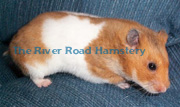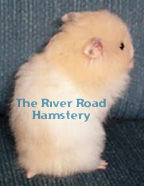
Contents
Genetics Index
The Basics
Chromosomes and
Genes
Dominant and Recessive,
Genotype and
Phenotype
Homozygous and
Heterozygous
Sex Chromosomes and
Sex Linkage
X-Inactivation
Mutation
Mutation Basics
Mutation in Syrians
Table of Mutations
Inheritance
Gametes
Punnett Square
Monohybrid Cross
Dihybrid Cross
Trihybrid Cross
Linkage
Sex Linkage
A Common
Misconception
Probability
The Nuts and Bolts
Examples
Principles of Breeding
Breeding Techniques
Dominant Traits
Recessive Traits
Epistasis
Lethality
Inadvisable Crosses
Lineal Purity v.
Heterogeneiry
Tortoiseshells and
Tricolors
Genotyping
Agouti v. Self
Basic Colors
The Golden Genotype
Combination Colors
Coat Types
Patterns
Eye Color
Ear Color
The Preliminary Genotype
Expanding the Genotype
• Parents
• Siblings
• Offspring
River Road Hamstery
(limited version)
Contact
|
Syrian Hamster Genetics: Inheritance Germ cells in the ovaries and testes give rise to eggs and sperm, known as gametes. In gamete formation chromosomes do not replicate themselves prior to cell division. Instead, one chromosome of each pair goes to each of the two new cells, generating cells that have half the normal number of chromosomes. All eggs will contain an X chromosome and, in the Syrian hamster, 21 autosomes. Sperm cells will have 21 autosomes and either an X or a Y. When an egg is fertilized and the sets of chromosomes come together, the zygote (first cell of the new organism) will again have the requisite 42 autosomes and either XX or XY. Since one of each chromosome pair is incorporated into the zygote, it follows that one allele of every gene pair is similarly handled. As an example, in a hamster with the Ee gene pair about 1/2 of its gametes will contain E and the other 1/2, e. Each gamete, then, is a random collection of one allele from every gene pair in the animal. The Punnett square is a mathematical tool used by geneticists to predict phenotypes and their ratios in offspring. It is a grid with all possible gametes from one parent listed across the top and those from the other parent down the left hand side. The body of the grid is where the gametes are combined and shows the possible genotypes of the offspring. In this Punnett square a Golden (EE) is crossed with a Black Eyed Cream (ee).
100% of the offspring are Golden carrying Black Eyed Cream. Another way to express this is Golden split for Black Eyed Cream. When an individual is heterozygous for one trait, it is sometimes referred to as being monohybrid. Here is a Punnett square showing a monohybrid cross.
A monohybrid cross gives a 3:1 ratio of dominant to recessive phenotypes, in this case 3/4 Golden, 1/4 Black Eyed Cream. These proportions are probabilities and accurate only with very large numbers of crosses. Within a single litter, they merely provide a general expectation of outcome. The interesting point about hybrid crosses is that phenotypes appear that were not at all evident in the parents.
A dihybrid cross results in a 9:3:3:1 phenotype ratio. Here, (shaded in the table from lightest to darkest) 9/16 are Banded Golden, 3/16 are Banded Black Eyed Cream, 3/16 are Nonbanded Golden and 1/16 are Nonbanded Black Eyed Cream. From Banded Golden parents three new phenotypes have been created. A hybrid cross with more than two traits gets cumbersome, but it can be done in the same way. Heterozygous Banded Goldens split for both Black Eyed Cream and Cinnamon (BabaEePp) can produce 8 different gametes. The trihybrid cross (with enough litters) would result in offspring of 64 different genotypes grouped in 8 different phenotypes, 7 of which were not seen in the parents.
Most crosses where multiple traits come into play are simpler than this because it is unlikely that both parents will be heterozygous at every locus. This reduces the number of possible gametes considerably. Normally, a dihybrid hamster makes four kinds of gametes in equal amounts. A Banded Golden longhair carrier (BabaLl) would be expected to produce 25% each of BaL, Bal, baL and bal gametes.
It doesn't. This is caused by the Ba locus and the L locus residing on the same chromosome; i.e., they are linked. Because they are physically joined, the alleles can't
randomize during cell division. If the allele Ba happened to be on the same chromosome as the allele L, and ba and l were together on the homolog, the resulting gametes would be BaL and bal
only. In actuality, when the chromosomes line up in pairs in preparation for cell division, there is occasional crossing over, where homologous sections of chromosomes break free and
trade places. Let's say that in an attempt to produce a Banded Longhair hamster you started with a Banded Shorthair parent (BaBaLL) and a Nonbanded Longhair parent (baball). All of the progeny would be heterozygous Banded Shorthairs split for longhair (BabaLl). Backcrossing one of these to the Longhair parent, you hope to get a litter with 25% Banded Longhairs (highlighted cell in table).
Instead, there are about 1/2 Banded Shorthairs and 1/2 Nonbanded Longhairs - the original parental types. The linkage results in some gametes and offspring genotypes (shaded areas in table) being absent or present only in greatly reduced numbers.
Getting a Banded Longhair from separate Banded and Longhair lines requires luck. There must be a crossover. The other sets of genes in Syrians that are known to be linked in the same fashion are Umbrous and Satin, and Dark Eared White and Cinnamon. Working with sex-linked genes is not much different than with autosomal genes. The presense of the Y chromosome is noted in the gamete constitution for males to indicate that there is no second allele. Before tackling the sex-linked gene itself, a Punnett square can be used solely to indicate transmission of sex. Instead of genes, the sex chromosomes are in the headings. The female gametes all contain an X; the males can have either an X or a Y.
The Punnett square shows that there is an equal chance of producing male and female offspring. Now the sex-linked genes can be added to the picture. The Y is retained as filler. The only identified Syrian sex-linked gene is Yellow, symbolized To. To see how it operates, cross a Golden female (toto) with a Yellow male (ToY).
Results: 50% Golden Tortoiseshell females (Toto), 50% Golden males (toY)
The opposite cross, Golden male (toY) with Yellow female (ToTo) is shown next.
Results: 50% Golden Tortoiseshell females (Toto), 50% Yellow males (ToY)
The Yellow gene travels to sons only from their mothers and from fathers only to their daughters, and this pattern is uniquely indicative of sex-linked transmission. Combining other colors with Yellow is a matter of adding those alleles into the gametes. Cross: Dark Grey Tortoiseshell (dgdgToto) x Smoke Pearl male (dgdgToY)
Results: 25% Smoke Pearl females (dgdgToTo), 25% Smoke Pearl males (dgdgToY),
25% Dark Grey Tortoiseshell females (dgdgToto),
25% Dark Grey males (dgdgtoY)
Even though both parents had the Yellow gene, in the sons it came only from the mother, and from the father it passed only to daughters. People unfamiliar with genetic concepts often think that if they mate their blue hamster with a red hamster they will get purple hamsters, or maybe even ones with blue and red patches. Here is a true story. My first foray into hamster breeding was in the late 1960s for a high school biology project. Trickie, named after an aunt for whom even the thought of bearing 12 babies was nearly paralytic, was my Golden female. For the sire I chose a Dark Eared White, although I didn't even know its proper name. White was white; brown was brown. If I mated them I was certain to get babies with brown and white patches, like my spaniel. I was perplexed when the litter came up all Golden. I saved one of the males from the litter and bred him back to Trickie because she was my only female. This time I figured that all I would get was more brown hamsters. There were 13 in the litter -- nine were Golden, and to my astonishment the other 4 had a brown and white patched coat, top and bottom. It took me many years to figure out that Trickie had carried Piebald and had also passed it to her son. It is possible to get a combined color from two hamsters of different recessive colors, but it won't happen in the first generation. The mating will yield all Goldens (carrying both colors), unless other recessive genes are lurking. The payoff comes only with luck in the second generation after a dihybrid cross between siblings, when the chance is 1/16 of the new combined color emerging. |

No part of this website may be reproduced in any form or by any means
without the prior written consent of the owner.
 A Banded Golden that is homozygous at both the Banded and Black Eyed Cream loci (BaBaEE) can produce only one kind of
gamete, BaE. If the hamster is heterozygous at just one of the loci, it will yeild 2 types; e.g., genotype BabaEE will give gametes BaE and baE. A dihybrid is heterozygous for two
traits and can produce 4 different gametes. A dihybrid Banded Golden (BabaEe) will make BaE, Bae, baE and bae, all in roughly equal amounts. The dihybrid cross looks like this:
A Banded Golden that is homozygous at both the Banded and Black Eyed Cream loci (BaBaEE) can produce only one kind of
gamete, BaE. If the hamster is heterozygous at just one of the loci, it will yeild 2 types; e.g., genotype BabaEE will give gametes BaE and baE. A dihybrid is heterozygous for two
traits and can produce 4 different gametes. A dihybrid Banded Golden (BabaEe) will make BaE, Bae, baE and bae, all in roughly equal amounts. The dihybrid cross looks like this: Because of this exchange of materials it is possible, though much less likely,
to get the gametes Bal and baL.
Because of this exchange of materials it is possible, though much less likely,
to get the gametes Bal and baL.